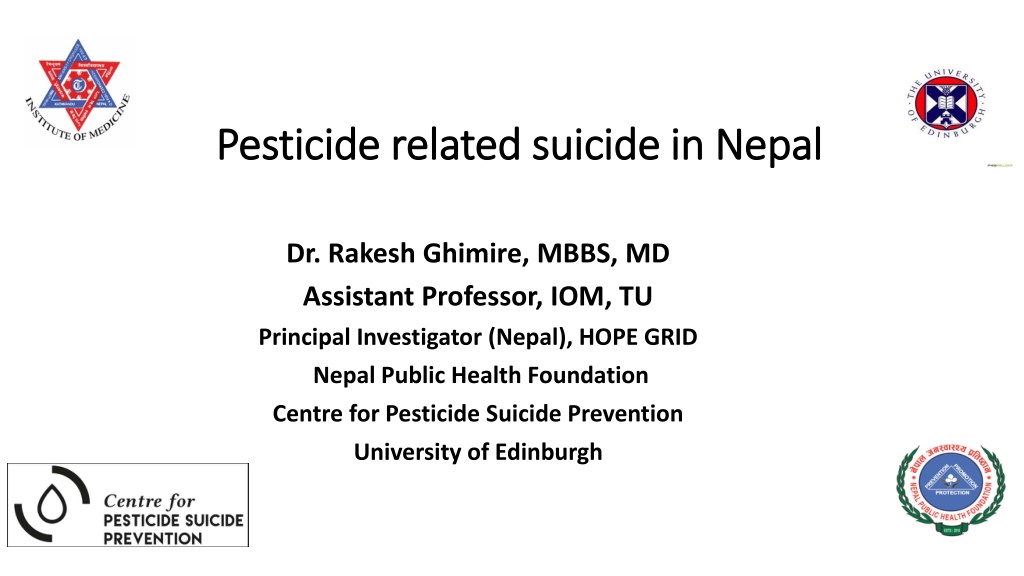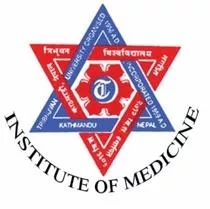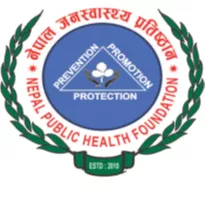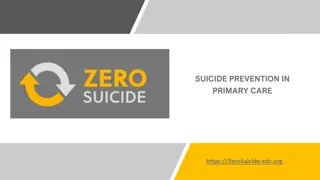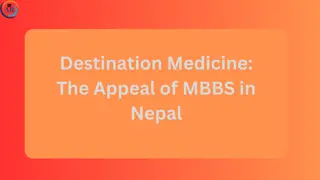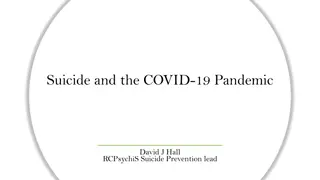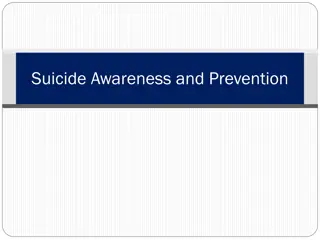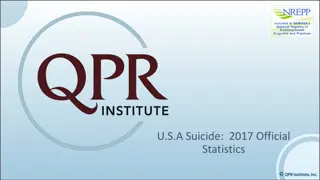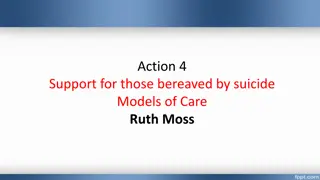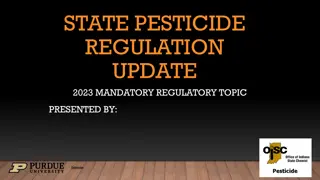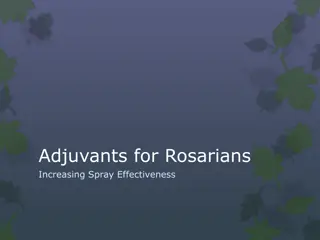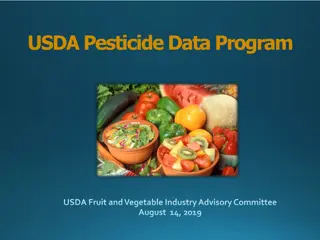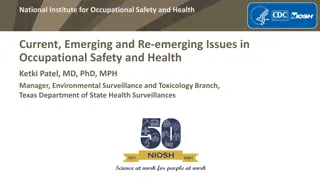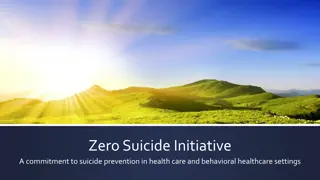Pesticide related suicide in Nepal
Intentional pesticide poisoning poses a significant public health concern in Nepal, with a high suicide rate attributed to pesticide ingestion. This study led by Dr. Rakesh Ghimire aims to identify the burden of pesticide poisoning, focusing on highly hazardous pesticides and their role in suicides. The methodology involved a quantitative analysis in multiple hospitals and toxicology laboratories across Nepal. The insights gathered are crucial for developing effective prevention strategies in agricultural communities.
Download Presentation

Please find below an Image/Link to download the presentation.
The content on the website is provided AS IS for your information and personal use only. It may not be sold, licensed, or shared on other websites without obtaining consent from the author.If you encounter any issues during the download, it is possible that the publisher has removed the file from their server.
You are allowed to download the files provided on this website for personal or commercial use, subject to the condition that they are used lawfully. All files are the property of their respective owners.
The content on the website is provided AS IS for your information and personal use only. It may not be sold, licensed, or shared on other websites without obtaining consent from the author.
E N D
Presentation Transcript
Pesticide related suicide in Nepal Pesticide related suicide in Nepal Dr. Rakesh Ghimire, MBBS, MD Assistant Professor, IOM, TU Principal Investigator (Nepal), HOPE GRID Nepal Public Health Foundation Centre for Pesticide Suicide Prevention University of Edinburgh
Co-authors Leah Utyasheva2, Pratap Narayan Prasad1, Sangha Ratna Bajracharya1, Bhupendra Basnet3, Nandu Kumar Pathak4, Madan Prasad Baral5, Birendra Chaudhary6, Rajan Pande7, Pramod Paudel8,Michael Eddleston2,Mahesh Maskey9 1Maharjgunj Medical Campus, Tribhuvan University Teaching Hospital, Kathmandu, Nepal 2Centre for Pesticide Suicide Prevention, University of Edinburgh, UK 3Bir Hospital, Kathmandu, Nepal 4Lumbini Zonal Hospital, Rupandehi, Nepal 5Pokhara Academy of Health Sciences, Western Regional hospital, Pokhara, Nepal 6Nepal Forensic Science Laboratory, Kathmandu, Nepal 7Bheri Zonal Hospital, Nepalgunj, Nepal 8Bharatpur Hospital, Chitwan, Nepal 9Nepal Public Health Foundation, Kathmandu, Nepal
Background Intentional pesticide poisoning is a major clinical and public health problem in agricultural communities in LMICs like Nepal According to WHO in 2014, Nepal had the 7thhighest suicide rate in the world (24.9 per 100,000) Poisoning is the second most common mode of suicide after hanging
Background Reference: Statistical Year Book, Central Bureau of Statistics Pesticide poisoning is the most common poisoning for suicide in the country
Rational of the study It would be useful to know which pesticides are most commonly used for self-harm and suicide and are fatal This HOPE GRID study aims to identify the burden of pesticide poisoning and the highly hazardous pesticides (HHP) currently responsible for the majority of pesticide suicides from the selected hospitals and toxicology laboratories of Nepal
Methodology A quantitative study was done in seven tertiary care hospitals of Kathmandu, Lalitpur, Banke, Chitwan, and Rupandehi districts of Nepal and existing two toxicology laboratories Study Duration: 1 year (April 2017 to April 2018)- Seven major hospitals. 2 years (2016-2018) - Two Nepalese toxicology laboratories Study population: All the cases of pesticide poisoning presented in the study hospitals Samples sent to the toxicology laboratories to identify the pesticide responsible for death
Methodology Nepal Study site - Hospital - Toxicology laboratories
Methodology Data Collection technique Data on demographics, poison, and patient outcome were recorded on a data collection sheet Hospital data was collected from medical records Toxicology laboratories data was obtained from the record file Researchers were trained in the recognition of the various types of pesticides Data Analysis: Simple descriptive Ethical Consideration: Approval obtained from NHRC
Hospital based data Hospital based data Results Results Gender distribution Male Female 41% 59%
Hospital based data Hospital based data Outcome Results Results Numbers Numbers (n) (n) Parameters Parameters Percentage(%) Percentage(%) Number Number of deaths of deaths 50 4.36 Outcome Outcome missing missing 377 33 Male Male Female Female 28 22 56 44
Hospital based data Hospital based data Poisoning agents responsible for death Results Results 25 20 15 10 5 0
Results Results National Forensic Science Laboratory National Forensic Science Laboratory Total number of positive samples of pesticide poisoning: 84 Total number of active ingredients identified : 8 Most common pesticide: Organophosphorus followed by Aluminum Phosphide Most common organophosphorus pesticide: Dichlorvous
Results Results National Forensic Science Laboratory National Forensic Science Laboratory Poisoning agents 30 25 20 15 10 5 0
Results Results Central Central Police ` Phosphine gas 21% Police Forensic Science Laboratory Forensic Science Laboratory Poisoning agents Pyrethroid 2% Organophosphorous 54% Carbamate 5% Organochlorine 18%
Results Results Central Central Police National National Forensic Science Laboratory Forensic Science Laboratory Police Forensic Science Laboratory Forensic Science Laboratory and and Pyrethroid 2% ` Phosphine gas 21% Organophosphorous 55% Carbamate 5% Organochlorine 17%
Discussion Discussion Pesticide self-poisoning is one of the means of suicide in developing countries like Nepal Exact hospital burden of pesticide poisoning is not known Need of proper medical record system in tertiary care hospitals of Nepal There may be opportunities to improve management of poisoned patients if the poison is identified on admission
Conclusion Conclusion Organophosphorus insecticides( Dichlorvos) and Aluminum phosphide were responsible for most pesticide suicides in Nepal Encouraging toxicology laboratories to identify the individual pesticide compound provide improved data that can be used to guide further pesticide regulation
Thank you!! Thank you!!
